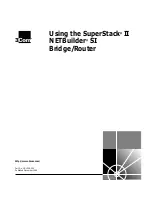
16-2
Cisco ONS 15310-CL Ethernet Card Software Feature and Configuration Guide, R5.0
June 2005
Chapter 16 CE-100T-8 Ethernet Operation
CE-100T-8 Ethernet Features
The CE-100T-8 card supports ITU-T G.707 and Telcordia GR-253 based standards for SONET. It offers
a carrier-class level of features and reliability. This includes errorless (0-msec impact on traffic)
reprovisioning. When circuit or port provisioning takes place, this operation does not affect the
performance of other ports and circuit configurations that are already established on the card.
Software upgrades are errorless. However when the CE-100T-8 firmware is upgraded, the upgrade has
an effect on traffic similar to the effect of a hard reset on the CE-100T-8. A software upgrade or a
firmware upgrade does not affect the existing provisioning of the ports and circuits on the CE-100T-8
card.
Span upgrades are hitless. Protection and maintenance switches are also hitless.
The CE-100T-8 offers full TL1-based provisioning capability. Refer to the Cisco ONS SONET TL1
Command Guide for CE-100T-8 TL1 provisioning commands.
CE-100T-8 Ethernet Features
The CE-100T-8 card has eight front-end Ethernet ports which use standard RJ-45 connectors for
10BASE-T Ethernet/100BASE-TX Ethernet media. Ethernet Ports 1 through 8 each map to a POS port
with a corresponding number. The console port on the CE-100T-8 card is not functional.
The CE-100T-8 cards forward valid Ethernet frames unmodified over the SONET network. Information
in the headers is not affected by the encapsulation and transport. For example, included IEEE 802.1Q
information will travel through the process unaffected.
The ONS 15454 CE-100T-8 and the ONS 15310 CE-100T-8 support maximum Ethernet frame sizes of
1600 bytes including the CRC. The MTU size is not configureable and is set at a 1500 byte maximum
(standard Ethernet MTU). Baby giant frames in which the standard Ethernet frame is augmented by
802.1 Q tags or MPLS tags are also supported. Full Jumbo frames (9000 byte maximum) are not
supported.
The CE-100T-8 cards discard certain types of erroneous Ethernet frames rather than transport them over
SONET. Erroneous Ethernet frames include corrupted frames with cyclic redundancy check (CRC)
errors and undersized frames that do not conform to the minimum 64-byte length Ethernet standard.
Note
Many Ethernet attributes are also available through the network element default feature. For more
information on NE defaults, refer to the "Network Element Defaults" appendix in the Cisco ONS 15454
Reference Manual.
Autonegotiation, Flow Control, and Frame Buffering
On the CE-100T-8, Ethernet link autonegotiation is on by default. The user can also set the link speed,
duplex, and flow control manually under the card-level Provisioning tab of CTC.
The CE-100T-8 supports IEEE 802.3x flow control and frame buffering to reduce data traffic congestion.
Flow control is on by default.
To prevent over-subscription, buffer memory is available for each port. When the buffer memory on the
Ethernet port nears capacity, the CE-100T-8 uses IEEE 802.3x flow control to transmit a pause frame to
the attached Ethernet device. Flow control and autonegotiation frames are local to the Fast Ethernet
interfaces and the attached Ethernet devices. These frames do not continue through the POS ports.




























